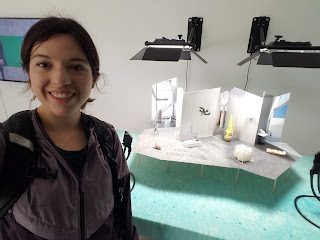Event Blog 2: Jungle Rhythm
Fowler Out Loud, a series for musically-performing students, puts on evening concerts for the public to attend. I visited a series that featured Jungle Rhythm, a band that incorporates Jazz, Latin, and Hip-Hop genres into their music. The content of Jungle Rhythm's music comes as diverse as their genres, spanning topics such as immigration, economic struggle, and dysfunctional love affairs. I found the music to be quite engaging, in that it was sporadic at times, yet soothing and playful, and even serious in the topics discussed.
I can evidently see the relationship between technology and art in this concert setting. For instance, the bass played by the singer, the microphone, and the piano are all electrically-infused mechanisms. Even the cymbals of the drums can be seen as parts machined from an industrial setting. The engineering of such complex instruments stems from a group of people who are passionate about both music and technology; a group of people who dwell within the third culture and utilize both art and science to their purposeful advantage. I was reminded of a news article sharing how a group of Yale students enrolled in an instrument design class and creatively applied the physics of sound to make new instruments. Eventually, circuits and software were implemented to make the instruments electric.
In addition to the artist's tools, another way in which Jungle Rhythm emulates a connection between science and art is by their very performance. At some point in each of the artist's lives, they chose to learn their instrument; the structured rules of playing, the technical details, the science of sound, etc. They initially observed, explored, and learned as scientists. Now as professionals, they can personalize what they have learned and create art in the form of music. They no longer need to be structured or learn theory. A wider array of creativity is offered as they brainstorm and write new music. As a result, Jungle Rhythm shares with their audience what they find important in our culture by utilizing their own story and the technology of instruments. Interestingly enough, scientific study has been performed on the brains of jazz musicians, finding that music improvisation and dreaming result in similar brain activity. The style of jazz music enabled researchers to find where music creativity comes from.
Sources
American Museum of Natural History. “Science Bulletins: Jazz on the Brain.” YouTube, 7 June 2012, www.youtube.com/watch?v=3gaOU51bLic.
“Jungle Rhythm - April 11, 2018.” UCLA Happenings, happenings.ucla.edu/all/event/265561#additional-info.
McCray, Rase. “At the Intersection of Engineering and Music, Yale Students Hit the Right Notes.” YaleNews, 15 Jan. 2015, news.yale.edu/2015/01/15/intersection-engineering-and-music-yale-students-hit-right-notes.
 |
| Jungle Rhythm at Fowler Museum |
I can evidently see the relationship between technology and art in this concert setting. For instance, the bass played by the singer, the microphone, and the piano are all electrically-infused mechanisms. Even the cymbals of the drums can be seen as parts machined from an industrial setting. The engineering of such complex instruments stems from a group of people who are passionate about both music and technology; a group of people who dwell within the third culture and utilize both art and science to their purposeful advantage. I was reminded of a news article sharing how a group of Yale students enrolled in an instrument design class and creatively applied the physics of sound to make new instruments. Eventually, circuits and software were implemented to make the instruments electric.
 |
| Photo with Fowler's Receptionist |
In addition to the artist's tools, another way in which Jungle Rhythm emulates a connection between science and art is by their very performance. At some point in each of the artist's lives, they chose to learn their instrument; the structured rules of playing, the technical details, the science of sound, etc. They initially observed, explored, and learned as scientists. Now as professionals, they can personalize what they have learned and create art in the form of music. They no longer need to be structured or learn theory. A wider array of creativity is offered as they brainstorm and write new music. As a result, Jungle Rhythm shares with their audience what they find important in our culture by utilizing their own story and the technology of instruments. Interestingly enough, scientific study has been performed on the brains of jazz musicians, finding that music improvisation and dreaming result in similar brain activity. The style of jazz music enabled researchers to find where music creativity comes from.
 |
| Jungle Rhythm at Fowler Museum |
Sources
American Museum of Natural History. “Science Bulletins: Jazz on the Brain.” YouTube, 7 June 2012, www.youtube.com/watch?v=3gaOU51bLic.
“Jungle Rhythm - April 11, 2018.” UCLA Happenings, happenings.ucla.edu/all/event/265561#additional-info.
McCray, Rase. “At the Intersection of Engineering and Music, Yale Students Hit the Right Notes.” YaleNews, 15 Jan. 2015, news.yale.edu/2015/01/15/intersection-engineering-and-music-yale-students-hit-right-notes.


This was an amazing blog post! I had not even considered the relation music has as an art form and to this class. I was also very surprised by the relation of the people who make instruments to members of the third culture. That is not a similarity I would have noticed!
ReplyDelete